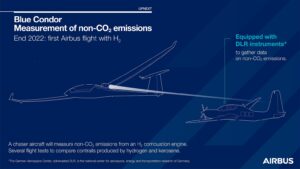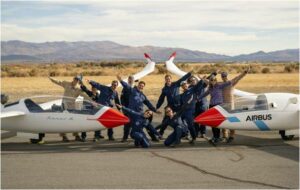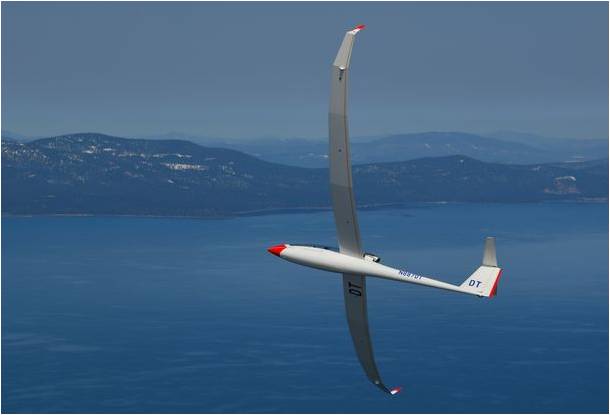Airbus, through its partnership with the Perlan Project, is investigating how to clean vapor trails from the high-flown paths traversed by airliners. Through its pair of Blue Condor jet-powered sailplanes, Airbus and Perlan are working toward a contrail-measuring mission in 2024.
Hydrogen, the most abundant element in the universe, has been a rarity in the aviation world, other than in well-publicized events involving gas-fueled conflagrations. (Whether the H2 carrying the Hindenburg aloft or the fabric skin covering the great ship’s frame caused the fire at Lakehurst, New Jersey in 1937 is still somewhat controversial.) Regardless, the disaster brought about a deep mistrust of hydrogen that persists to this day. Airbus, along with the Perlan Project, looks forward to exploiting H2’s advantages while overcoming its undeserved stigma and surprising issues.
Perlan’s Greater Mission
The Perlan Project has achieved an enviable string of record flights culminating in the 2018 altitude record of 76,114 feet. Carrying CubeSats filled with science experiments developed by students at many grade levels, each Perlan flight adds to our body of knowledge.
Airbus explains, “Through Airbus Perlan Mission II, we are supporting climate research that could not be performed by a powered aircraft, and in the process inspiring the next generation to commit their talents and passion to aerospace.” Part of this will be examination of how to rid upper atmosphere aviation of contrails, those often pretty reminders of a jet’s passing.
“Through Project Blue Condor, we are working with The Perlan Project to research the contrails produced by hydrogen combustion, which we believe is a key enabling technology for zero carbon-emission aviation.”
We know contrails help hold heat in the atmosphere, something demonstrated following the grounding of all civil aviation following 9/11 in 2001. Without thousands of daily flights pouring trails of high-altitude condensation into the air, the earth actually warmed during daylight hours and cooled at night for a few days. High altitude clouds from contrails were no longer reflecting sunlight that would warm the planet or hold in that warmth overnight.
The same effect could be observed from decreased air travel during the recent COVID shutdowns. A 2022 report in Environmental Sustainability reflected particulate and nitrogen oxide reductions in the atmosphere because of large reductions in transportation-related emissions.
Blue Condor
While Perlan 2 is a motorless sailplane, Blue Condor comprises two jet-powered Arcus sailplanes – one powered by hydrogen. They will fly in a loose tandem formation, each craft emitting water vapor and different gases depending on the fuel used.
Airbus explains the known differences leading to the in-flight testing. “Hydrogen offers aviation a path to low-carbon operations, yet its combustion produces contrails just like conventional jet fuel. Hydrogen contrails, however, differ significantly. They don’t contain soot or sulfur oxides, but do hold nitrous oxides and a lot of water vapor: up to 2.5 times more than kerosene contrails. Both are considered climate-impacting emissions, and as such the aviation industry has a duty to address them.”
Blue Condor flew its first hydrogen-powered tests on November 8 in Nevada. Airbus notes, “The flight was the company’s first ever to use hydrogen as the sole fuel source, and it kicked off a test campaign that will conclude in a contrail-measuring mission in early 2024.”
Blue Condor has now entered its flight test phase. The 8 November flight lasted around 30 minutes and its aim was to increase the hydrogen engine’s thrust at 7,000 feet, while stabilizing the aircraft at different speeds. Two further flights have taken place since, performing tests including an engine start at 10,000 feet.
A Big Loose Formation
As part of its more all-encompassing ZEROe project, Airbus is committed to studying the composition of these little-understood hydrogen contrails. Using a modified Arcus-J glider, Airbus UpNext in its Blue Condor project will take a small hydrogen-combustion engine as high as 30,000 feet and compare its emissions to a similar-sized kerosene engine, flying alongside onboard a second aircraft. Both gliders are operated by The Perlan Project and the fossil fuel and hydrogen engines were assembled by German company Aero Design Works.

Airbus and Perlan Project will fly kerosene and hydrogen powered Arcus sailplanes and Grob Egret “chase” and tow plane instrumented by DLR to compare emissions
According to Airbus, “The Blue Condor team plans to operate a first contrail-studying operation during Nevada’s cold-weather window early next year. Then, the Arcus-J will be towed to test altitude by a Grob Egrett aircraft instrumented by the German aerospace lab DLR. This ‘chase’ aircraft will then follow behind, using sensors to collect and analyze contrail and atmospheric data. The flight promises to be a big step in furthering understanding of hydrogen’s climate impact, and ultimately in reaching Airbus’ ZEROe target entry into service in 2035.”

The Blue Condor team practicing the choreography for their Broadway opening
The Blue Condor team operates out of Minden, where the Perlan 2 is stored and where Miguel Iturmendi made his record altitude runs in mid 2023. Blue Condor will then move to North Dakota. As Airbus explains, “Blue Condor’s first two flight test campaigns will be carried out in Nevada, USA. The third will be conducted in North Dakota, USA, in partnership with the University of North Dakota, to take advantage of the ideal meteorological conditions.”
We can all hope the high, clear upper atmosphere remains so, benefiting from the tests made possible by Airbus, UpNext, the DLR, and the Perlan Project. Considering past atmospheric cooling brought about by short periods of contrail-generating flights, this could lead to changes in how we fuel our high-altitude airliners and consequent global cooling. It may be a long shot, and not enough to stop what seems to be an inevitable rush toward catastrophic global warming, but every step toward ameliorating that outcome is worthy of investigation. Let us start 2024 on a note of optimism and hope. Perlan may find a niche in history not just for high-altitude record setting, but in helping an ailing planet.
A Comment and New Year’s Wish from the CEO of the Perlan Project
Ed Warnock, CEO of the Perlan Project and Blue Condor, adds to the discussion: “The exact purpose of our hydrogen flights is to investigate the properties of contrails from a hydrogen burning jet engine.”
He shares this thought to help us all kick off 2024 in an uplifting way.


